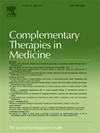在治疗慢性非特异性腰背痛方面,推拿与物理疗法或两者的结合:随机对照试验
IF 3.3
3区 医学
Q1 INTEGRATIVE & COMPLEMENTARY MEDICINE
引用次数: 0
摘要
目的通过一项全面、高质量的临床试验,严格评估推拿(TN)单独或与理疗(PT)联合治疗慢性非特异性腰背痛(CNLBP)的短期和长期疗效。方法这项随机、单盲试验于 2020 年 9 月至 2023 年 7 月进行,共有 204 名来自暨南大学附属第一医院的 CNLBP 患者参与。参与者接受基线评估、为期8周的6次治疗、第9周的治疗后评估以及为期20周的随访。参与者被随机分配到 TN 组、PT 组或 TN 和 PT(TP)组合组。每次治疗包括 6 个疗程,每个疗程至少间隔 7 天,每个疗程持续 30 分钟。主要结果是疼痛视觉模拟量表(VAS)的变化。次要结果包括奥斯韦特里残疾指数(ODI)、36项简表健康调查(SF-36)、脊柱活动范围(ROM)、中医综合征量表(TCMSS)和不良事件(AE)。 结果204名参与者中,67.16%为女性,88.73%完成了20周的随访。所有组别在治疗后和随访时的 VAS 评分均有明显下降。次要结果也有明显改善,ODI 和 TCMSS 评分明显下降。组内的配对比较显示出统计学意义,尤其是在 ODI 评分方面,具有临床意义。各组之间未发现明显差异。ROM 和 SF-36 有统计学意义,但无临床意义。结论所有治疗组(包括 TN、TP 和 PT)均显示 CNLBP 患者的 VAS 评分显著降低,疗效可持续 20 周。虽然 TN 和 TP 治疗组在次要结果(尤其是 ODI 评分)方面有很大改善,但治疗组之间没有发现明显差异。这些研究结果表明,所有治疗方法都能有效控制 CNLBP,支持临床医师为患者选择适当的干预措施,尤其是那些无法进行主动锻炼的患者,利用 TN 等被动运动来提高健康效果。本文章由计算机程序翻译,如有差异,请以英文原文为准。
Tuina versus physiotherapy or a combination of both for the management of chronic nonspecific low back pain: A randomized controlled trial
Objective
To rigorously evaluate the short-term and long-term effectiveness of Tuina (TN), alone and in combination with physiotherapy (PT), for Chronic nonspecific low back pain (CNLBP) through a comprehensive, high-quality clinical trial.
Methods
This randomized, single-blind trial was conducted from September 2020 to July 2023, involving 204 CNLBP patients from the First Affiliated Hospital of Jinan University. Participants underwent a baseline assessment, 6 treatment sessions over 8 weeks, a post-treatment evaluation in the 9th week, and a 20-week follow-up. Participants were randomly assigned to TN, PT, or a combination of TN and PT (TP) groups. Each treatment involved 6 sessions with a minimum 7-day interval, each lasting 30 minutes. Primary outcome was the change in Visual Analog Scale (VAS) for pain. Secondary outcomes included the Oswestry Disability Index (ODI), 36-Item Short Form Health Survey (SF-36), Range of Motion (ROM) of the spine, Traditional Chinese Medicine Syndrome Scale (TCMSS), and adverse events (AE).
Results
Among the 204 participants, 67.16 % were female, and 88.73 % completed the 20-week follow-up. All groups showed significant reductions in VAS scores post-treatment and at follow-up. Secondary outcomes improved significantly, with notable decreases in ODI and TCMSS scores. Pairwise comparisons within groups indicated statistical significance, particularly in ODI scores, with clinical relevance. No significant differences were found between the groups. ROM and SF-36 showed statistical but not clinical significance. Only one AE (0.49 %) was reported, with no severe incidents.
Conclusion
All treatment groups, including TN, TP, and PT, demonstrated significant reductions in VAS scores for CNLBP patients, with effects lasting up to 20 weeks. While TN and TP showed substantial improvements in secondary outcomes, particularly in ODI scores, no significant differences were found between the groups. These findings suggest that all treatments can be effective for managing CNLBP, supporting clinical practitioners in selecting appropriate interventions for patients, especially for those unable to engage in active exercises, utilizing passive movements like TN to enhance health outcomes.
求助全文
通过发布文献求助,成功后即可免费获取论文全文。
去求助
来源期刊

Complementary therapies in medicine
医学-全科医学与补充医学
CiteScore
8.60
自引率
2.80%
发文量
101
审稿时长
112 days
期刊介绍:
Complementary Therapies in Medicine is an international, peer-reviewed journal that has considerable appeal to anyone who seeks objective and critical information on complementary therapies or who wishes to deepen their understanding of these approaches. It will be of particular interest to healthcare practitioners including family practitioners, complementary therapists, nurses, and physiotherapists; to academics including social scientists and CAM researchers; to healthcare managers; and to patients. Complementary Therapies in Medicine aims to publish valid, relevant and rigorous research and serious discussion articles with the main purpose of improving healthcare.
 求助内容:
求助内容: 应助结果提醒方式:
应助结果提醒方式:


